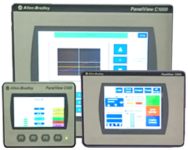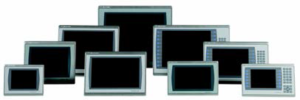
With so many different Allen-Bradley PanelViews available from Rockwell Automation, it can often be quite confusing for new customers to know which one is right for their application.
With that in mind, in today’s article I’ll run down all of Rockwell’s PanelViews to hopefully make things a little clearer!
 PanelView models which are Obsolete:
PanelView models which are Obsolete:
Let’s start with PanelViews you shouldn’t plan on using. The original PanelView (later renamed the PanelView 1200,) the PanelView “E” or Enhanced (1000E, 1200E, 1400E,) and the PanelView Standard (300, 550, 600, 900, 1000, 1400,) are all obsolete.
 The original PanelView Plus, PanelView Plus CE and VersaView CE are also all obsolete.
The original PanelView Plus, PanelView Plus CE and VersaView CE are also all obsolete.
And finally the PanelView Component 4″, 6″, and 10″ were recently announced to be “end of life,” effectively obsolete as of 2016.
The PanelView best suited for Migrations:
If you need to replace any of the above PanelViews (except for the PanelView Component) your best choice will likely be the PanelView Plus 6.
 While no PanelView Plus 6 models support RIO, Devicenet, or scheduled ControlNet (all I/O networks,) the seven inch and larger models do support DH+, DH-485, and ControlNet unscheduled communication cards, and all PanelView Plus 6 models have Serial and Ethernet ports built-in.
While no PanelView Plus 6 models support RIO, Devicenet, or scheduled ControlNet (all I/O networks,) the seven inch and larger models do support DH+, DH-485, and ControlNet unscheduled communication cards, and all PanelView Plus 6 models have Serial and Ethernet ports built-in.
And in those cases where the PanelView Plus 6 supports the same network as the older PanelView Plus, you can often just download the same runtime file without edits and it’ll work without issue.
 You can also import files from the old Standard and Enhanced PanelViews mentioned above, and if they used a network the PanelView Plus 6 supports the conversion is pretty straight forward.
You can also import files from the old Standard and Enhanced PanelViews mentioned above, and if they used a network the PanelView Plus 6 supports the conversion is pretty straight forward.
In addition to that, most PanelView Plus 6 models fit the same cutouts as older models, and where mismatches do exist Rockwell likely offers an adapter plate to allow reusing the existing cutout.
 The one migration scenario where you might not want to use a PanelView Plus 6 is if you’re migrating from the PanelView Component 4″, 6″ or 10″ models.
The one migration scenario where you might not want to use a PanelView Plus 6 is if you’re migrating from the PanelView Component 4″, 6″ or 10″ models.
In those cases your best option is to migrate to the PanelView 800 as you can use the same program, and there are also cutout migration options.
For more information about migrating from the PanelView Component to the PanelView 800, see our previous article HERE.
PanelView Plus 6 vs. PanelView Plus 6 Compact:
At this point I want to take a moment to discuss how the PanelView Plus 6 Compact differs from the PanelView Plus 6.
While the PanelView Plus 6 Compact is substantially less expensive, it does have the following limitations:
 It can only communicate to one PLC or device
It can only communicate to one PLC or device- It only supports that device via Serial or Ethernet
- In can only have 25 graphic displays in the project
- It is limited to only having 200 alarms in the project
- It only comes in five models, all of which are DC powered
With those considerations in mind, the most common application for the PanelView Plus 6 Compact is on small systems controlled by a single CompactLogix processor.
The PanelView best suited for New Applications:
There are really have two choices here.
 First, if you’re using a MicroLogix or Micro800, the clear winner price wise is the PanelView 800.
First, if you’re using a MicroLogix or Micro800, the clear winner price wise is the PanelView 800.
That said, the free and simplistic CCW programming software isn’t for everyone.
But if you’re using a Micro and looking for a simple HMI with free programming software, then the PanelView 800 is likely the best choice.

However, if you’re using CompactLogix or ControlLogix on Ethernet, and like the power and efficiency of FactoryTalk View Studio, then the PanelView Plus 7 may be for you.
The PanelView Plus 7 departs from the PanelView Plus 6 in many ways.
First, all PanelView Plus 7 models only have Ethernet communications, which is one of the main reasons you’ll find they’re not as popular in migration scenarios.
They also use newer display technology, some even coming in new widescreen formats. Due to this, they also have unique cutout dimensions which don’t match up with older PanelView models.
However, they do still support running older PanelView Plus projects, so if you’re updating a system already using Ethernet they are definitely worth looking at.
The PanelView Plus 7 – Standard vs. Performance:
Sometimes I wonder if marketing folks rename thing just to give us headaches?
Like how the PanelView Plus CE was renamed to the VersaView CE right before it launched?
 Yes, they eventually renamed it back to something that actually made sense (PanelView Plus CE,) but for a few years I wasted way too much time trying to explain what a VersaView CE was.
Yes, they eventually renamed it back to something that actually made sense (PanelView Plus CE,) but for a few years I wasted way too much time trying to explain what a VersaView CE was.
So to keep things simple, let me just say when you hear PanelView Plus 7 Standard, know it has virtually the same limitations at the PanelView Plus 6 Compact:
- It can only communicate to one PLC or device
- In can only have 25 graphic displays in the project
- It is limited to only having 200 alarms in the project
- It originally only came in five models, all of which are DC powered.
- Note: As of this writing Rockwell now lists seven models of the PanelView Plus 7 Standard
The Next Generation – The PanelView 5500:
 With the PanelView Plus family over a decade old, and the PanelView Component family nearly eight years in age, Rockwell is obviously working on it’s next generation of industrial HMIs.
With the PanelView Plus family over a decade old, and the PanelView Component family nearly eight years in age, Rockwell is obviously working on it’s next generation of industrial HMIs.
And similar to when the ControlLogix launched in 1998 missing standard PLC capabilities, this next generation of Rockwell HMIs released this year with some serious restrictions:
- It can only be configured to communicate to CompactLogix and ControlLogix processors running version 27 firmware (no other PLCs, PACs or devices are supported in the initial release.)
- It can only have one Logix processor per project
- It only supports 50 user defined screens currently
- It only supports 500 Logix based alarms currently
- It currently does not support any type of historical trending
- It currently does not support any HMI tags or HMI based alarms
- It is an Ethernet only HMI (similar to the PanelView Plus 7)
That’s not to say the PanelView 5500 doesn’t have some very unique features.
Having participated in the hands-on labs at Rockwell’s past events, I do very much see the product’s potential.
However, the more I look at the list of what it can’t do today, the more I have to admit that currently potential applications seem quite limited.
That said, it’s definitely a product line I’ll be keeping my eyes on. If it follows the same course the ControlLogix line did, in a couple of years this may be the preferred HMI for Rockwell’s PACs.
For More Information:
For more information about the PanelView 800, PanelView Plus 6 & 7, and PanelView 5500, check out the below links to Rockwell’s product brochures:
- PanelView 800
- PanelView Plus 6 700-1500, 400 & 600
- PanelView Plus 6 Compact
- PanelView Plus 7 – All models
- PanelView 5500
I hope you’ve found the above article detailing all of Rockwell’s PanelView products helpful!
If you’d like to share your own thoughts and opinions, feel free to do so using the “post a comment or question” link below.
Until next time, Peace ✌️
If you enjoyed this content, please give it a Like, and consider Sharing a link to it as that is the best way for us to grow our audience, which in turn allows us to produce more content 🙂
Shawn M Tierney
Technology Enthusiast & Content Creator
Support our work and gain access to hundreds members only articles and videos by becoming a member at The Automation Blog or on YouTube. You’ll also find all of my affordable PLC, HMI, and SCADA courses at TheAutomationSchool.com.
- FactoryTalk Design Workbench First Look, CCW Comparison - December 19, 2025
- Drew Allen of Grace Technologies on Automation, Safety, and More (P256) - December 17, 2025
- Robotics in Warehouse Automation with Erik Nieves of Plus One Robotics (P255) - December 10, 2025

Discover more from The Automation Blog
Subscribe to get the latest posts sent to your email.





good day
Can you please share with me, where i can see the compatibility betwen PLC and HMI?
For example, I know that HMI firmware version 5.1 is not compatible with PLC firmware 20.0 or higher….
Where did you hear that PanelView Plus version 5.1 won’t communicate to a ControlLogix of version 20 and higher?
Not only do I think that is wrong, but I’m fairly confident I can connect a v1 PVPlus (ViewME 3.0) to a v35 ControlLogix without issue…
In any case, you can check the compatibility website for this kind of info (it shows more than just Windows):
– https://theautomationblog.com/how-to-look-up-rockwell-software-compatibility-with-microsoft-windows/
ST